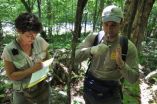(Press-News.org) Wild salamanders living in some of North America's best salamander habitat are getting smaller as their surroundings get warmer and drier, forcing them to burn more energy in a changing climate.
That's the key finding of a new study, published March 25 in the journal Global Change Biology, that examined museum specimens caught in the Appalachian Mountains from 1957 to 2007 and wild salamanders measured at the same sites in 2011-2012. The salamanders studied from 1980 onward were, on average, 8% smaller than their counterparts from earlier decades. The changes were most marked in the Southern Appalachians and at low elevations – settings where detailed weather records showed the climate has warmed and dried out most.
Scientists have predicted that some animals will get smaller in response to climate change, and this is strong confirmation of that prediction.
"This is one of the largest and fastest rates of change ever recorded in any animal," said Karen R. Lips, an associate professor of biology at the University of Maryland and the study's senior author. "We don't know exactly how or why it's happening, but our data show it is clearly correlated with climate change." And it's happening at a time when salamanders and other amphibians are in distress, with some species going extinct and others dwindling in number.
"We don't know if this is a genetic change or a sign that the animals are flexible enough to adjust to new conditions," Lips said. "If these animals are adjust, it gives us hope that some species are going to be able to keep up with climate change."
The study was prompted by the work of University of Maryland Prof. Emeritus Richard Highton, who began collecting salamanders in the Appalachian Mountains in 1957. The geologically ancient mountain range's moist forests and long evolutionary history make it a global hot spot for a variety of salamander species. Highton collected hundreds of thousands of salamanders, now preserved in jars at the Smithsonian Institution's Museum Service Center in Suitland, MD.
But Highton's records show a mysterious decline in the region's salamander populations beginning in the 1980s. Lips, an amphibian expert, saw a similar decline in the frogs she studied in Central America, and tracked it to a lethal fungal disease. She decided to see whether disease might explain the salamander declines in the Appalachians.
Between summer 2011 and spring 2012, Lips and her students caught, measured and took DNA samples from wild salamanders at 78 of Highton's collecting sites in Maryland, Virginia, West Virginia, Tennessee and North Carolina. Using relatively new techniques for analyzing DNA from preserved specimens, the researchers tested some of Highton's salamanders for disease.
Lips found virtually no fungal disease in the museum specimens or the living animals. But when she compared size measurements of the older specimens with today's wild salamanders, the differences were striking.
Between 1957 and 2012, six salamander species got significantly smaller, while only one got slightly larger. On average, each generation was one percent smaller than its parents' generation, the researchers found.
The researchers compared changes in body size to the animals' location and their sites' elevation, temperature and rainfall. They found the salamanders shrank the most at southerly sites, where temperatures rose and rainfall decreased over the 55-year study.
To find out how climate change affected the animals, Clemson University biologist Michael W. Sears used a computer program to create an artificial salamander, which allowed him to estimate a typical salamander's daily activity and the number of calories it burned. Using detailed weather records for the study sites, Sears was able to simulate the minute-by-minute behavior of individual salamanders, based on weather conditions at their home sites during their lifetimes.
The simulation showed the modern salamanders were just as active as their forbears had been. But to maintain that activity, they had to burn 7 to 8 percent more energy. Cold-blooded animals' metabolisms speed up as temperatures rise, Sears explained.
To get that extra energy, salamanders must make trade-offs, Lips said. They may spend more time foraging for food or resting in cool ponds, and less time hunting for mates. The smaller animals may have fewer young, and may be more easily picked off by predators.
"Right now we don't know what this means for the animals," Lips said. "If they can start breeding smaller, at a younger age, that might be the best way to adapt to this warmer, drier world. Or it may be tied in with the losses of some of these species."
The research team's next step will be to compare the salamander species that are getting smaller to the ones that are disappearing from parts of their range. If they match, the team will be one step closer to understanding why salamanders are declining in a part of the world that once was a haven for them.
INFORMATION:
This research was funded by the University of Maryland-Smithsonian Institution Seed Grant Program.
Media contacts:
Abby Robinson, 301-405-5845, abbyr@umd.edu
Heather Dewar, 301-405-9267, hdewar@umd.edu
Karen Lips laboratory
"Widespread Rapid Reductions in Body Size of Adult Salamanders in Response to Climate Change," Nicholas M. Caruso, Michael W. Sears, Dean C. Adams and Karen R. Lips, published online in Global Change Biology March 25, 2014.
Salamanders shrinking as their mountain havens heat up
Smaller body size is one of the fastest environmental changes ever seen, UMD-led research team says
2014-03-25
ELSE PRESS RELEASES FROM THIS DATE:
ISU engineer builds instrument to study effects of genes, environment on plant traits
2014-03-25
AMES, Iowa – Let's say plant scientists want to develop new lines of corn that will better tolerate long stretches of hot, dry weather.
How can they precisely assess the performance of those new plants in different environmental conditions? Field tests can provide some answers. Greenhouse tests can provide some more. But how can plant scientists get a true picture of a plant's growth and traits under a wide variety of controlled environmental conditions?
That job has been too big and too precise for most laboratories. There are a few labs around the world that can ...
SU biologists use sound to identify breeding grounds of endangered whales
2014-03-25
Remote acoustic monitoring among endangered whales is the subject of a major article by two doctoral students in Syracuse University's College of Arts and Sciences.
Leanna Matthews and Jessica McCordic, members of the Parks Lab in the Department of Biology, have co-authored "Remote Acoustic Monitoring of North Atlantic Right Whales Reveals Seasonal and Diel Variations in Acoustic Behavior." The article appears in the current issue of PLOS ONE, an inclusive, peer-reviewed, open-access resource from the Public Library of Science in San Francisco, Calif.
Susan Parks, assistant ...
In search of a few good apps
2014-03-25
BOSTON–While the Food and Drug Administration (FDA) has released guidelines for the regulation of mobile health (mHealth) apps that act as medical devices or as accessories to medical devices, the vast majority of mHealth apps remain unregulated and unevaluated. In a Viewpoint article, "In Search of a Few Good Apps", published in JAMA on March 24, 214, co-authors, David Bates, MD and Adam Landman, MD of Brigham and Women's Hospital (BWH) and Adam Powell, PhD, president of Payer+Provider Syndicate, call for the creation of mHealth (mobile health) app review and certification ...
Study: Salamanders shrinking due to climate change
2014-03-25
Wild salamanders living in some of North America's best salamander habitat are getting smaller as their surroundings get warmer and drier, forcing them to burn more energy in a changing climate.
That's the key finding of a new study co-authored by a Clemson University biologist and published Tuesday in the journal Global Change Biology that examined museum specimens caught in the Appalachian Mountains from 1957 to 2007 and wild salamanders measured at the same sites in 2011-2012.
The salamanders studied from 1980 onward were, on average, eight percent smaller than their ...
Nanotube coating helps shrink mass spectrometers
2014-03-25
WEST LAFAYETTE, Ind. — Nanotechnology is advancing tools likened to Star Trek's "tricorder" that perform on-the-spot chemical analysis for a range of applications including medical testing, explosives detection and food safety.
Researchers found that when paper used to collect a sample was coated with carbon nanotubes, the voltage required was 1,000 times reduced, the signal was sharpened and the equipment was able to capture far more delicate molecules.
A team of researchers from Purdue University and the Indian Institute of Technology Madras performed the study, which ...
Model predicts blood glucose levels 30 minutes later
2014-03-25
A mathematical model created by Penn State researchers can predict with more than 90 percent accuracy the blood glucose levels of individuals with type 1 diabetes up to 30 minutes in advance of imminent changes in their levels -- plenty of time to take preventative action.
"Many people with type 1 diabetes use continuous glucose monitors, which examine the fluid underneath the skin," said Peter Molenaar, Distinguished Professor of Human Development and Family Studies and of psychology. "But the glucose levels under the skin trail blood glucose levels from anywhere between ...
NASA satellite sees wind shear whipping Tropical Cyclone Gillian
2014-03-25
A visible image from NASA's Aqua satellite provides a clear picture that wind shear is responsible for weakening the once mighty Tropical Cyclone Gillian from hurricane to tropical storm strength.
When NASA's Aqua satellite flew over Gillian on March 25 at 06:30 UTC/2:30 a.m. EDT, the Moderate Resolution Imaging Spectroradiometer or MODIS instrument took a visible picture of the storm. That image showed that wind shear has pushed clouds and showers away from the center as the storm weakened to a tropical storm.
In the MODIS image, the center of Gillian's circulation ...
Haynes is first to identify cellular patterns of contraction in human hearts
2014-03-25
LEXINGTON, Ky. (March 19, 2014) — When Premi Haynes was growing up in Pune, India, she attended Stella Maris High School, an English language convent school founded by Swiss nuns. Her second grade singing class used a book of English songs. One of the songs was "My Old Kentucky Home." At that time, Haynes had never heard of Kentucky, had no idea where it was, and had no particular ambition to go there.
Some 20 years and a twist of fate later, on March 19 Haynes successfully defended her Ph.D. thesis in physiology at the University of Kentucky, where she's made a significant ...
Agricultural fires across Sierra Leone
2014-03-25
Marked in red, hundreds of land use fires burn in the fields across Sierra Leone. Most fires in this region are deliberately set for a variety of reasons, including slash and burn agriculture. When a plot of land becomes exhausted, farmers shift cultivation to another plot where they cut the trees and brush at the beginning of the dry season in January and February. Once the dead plant material has dried, they set fire to it. Such fires peak in March and April right before farming season begins.
From space, MODIS detects thermal anomalies, including fires, flares, and ...
Sensing gravity with acid
2014-03-25
WOODS HOLE, Mass.—While probing how organisms sense gravity and acceleration, scientists at the Marine Biological Laboratory (MBL) and the University of Utah uncovered evidence that acid (proton concentration) plays a key role in communication between neurons. The surprising discovery is reported this week in Proceedings of the National Academy of Sciences.
The team, led by the late MBL senior scientist Stephen M. Highstein, discovered that sensory cells in the inner ear continuously transmit information on orientation of the head relative to gravity and low-frequency ...
LAST 30 PRESS RELEASES:
Making lighter work of calculating fluid and heat flow
Normalizing blood sugar can halve heart attack risk
Lowering blood sugar cuts heart attack risk in people with prediabetes
Study links genetic variants to risk of blinding eye disease in premature infants
Non-opioid ‘pain sponge’ therapy halts cartilage degeneration and relieves chronic pain
AI can pick up cultural values by mimicking how kids learn
China’s ecological redlines offer fast track to 30 x 30 global conservation goal
Invisible indoor threats: emerging household contaminants and their growing risks to human health
Adding antibody treatment to chemo boosts outcomes for children with rare cancer
Germline pathogenic variants among women without a history of breast cancer
Tanning beds triple melanoma risk, potentially causing broad DNA damage
Unique bond identified as key to viral infection speed
Indoor tanning makes youthful skin much older on a genetic level
Mouse model sheds new light on the causes and potential solutions to human GI problems linked to muscular dystrophy
The Journal of Nuclear Medicine ahead-of-print tip sheet: December 12, 2025
Smarter tools for peering into the microscopic world
Applications open for funding to conduct research in the Kinsey Institute archives
Global measure underestimates the severity of food insecurity
Child survivors of critical illness are missing out on timely follow up care
Risk-based vs annual breast cancer screening / the WISDOM randomized clinical trial
University of Toronto launches Electric Vehicle Innovation Ontario to accelerate advanced EV technologies and build Canada’s innovation advantage
Early relapse predicts poor outcomes in aggressive blood cancer
American College of Lifestyle Medicine applauds two CMS models aligned with lifestyle medicine practice and reimbursement
Clinical trial finds cannabis use not a barrier to quitting nicotine vaping
Supplemental nutrition assistance program policies and food insecurity
Switching immune cells to “night mode” could limit damage after a heart attack, study suggests
URI-based Global RIghts Project report spotlights continued troubling trends in worldwide inhumane treatment
Neutrophils are less aggressive at night, explaining why nighttime heart attacks cause less damage than daytime events
Menopausal hormone therapy may not pose breast cancer risk for women with BRCA mutations
Mobile health tool may improve quality of life for adolescent and young adult breast cancer survivors
[Press-News.org] Salamanders shrinking as their mountain havens heat upSmaller body size is one of the fastest environmental changes ever seen, UMD-led research team says









